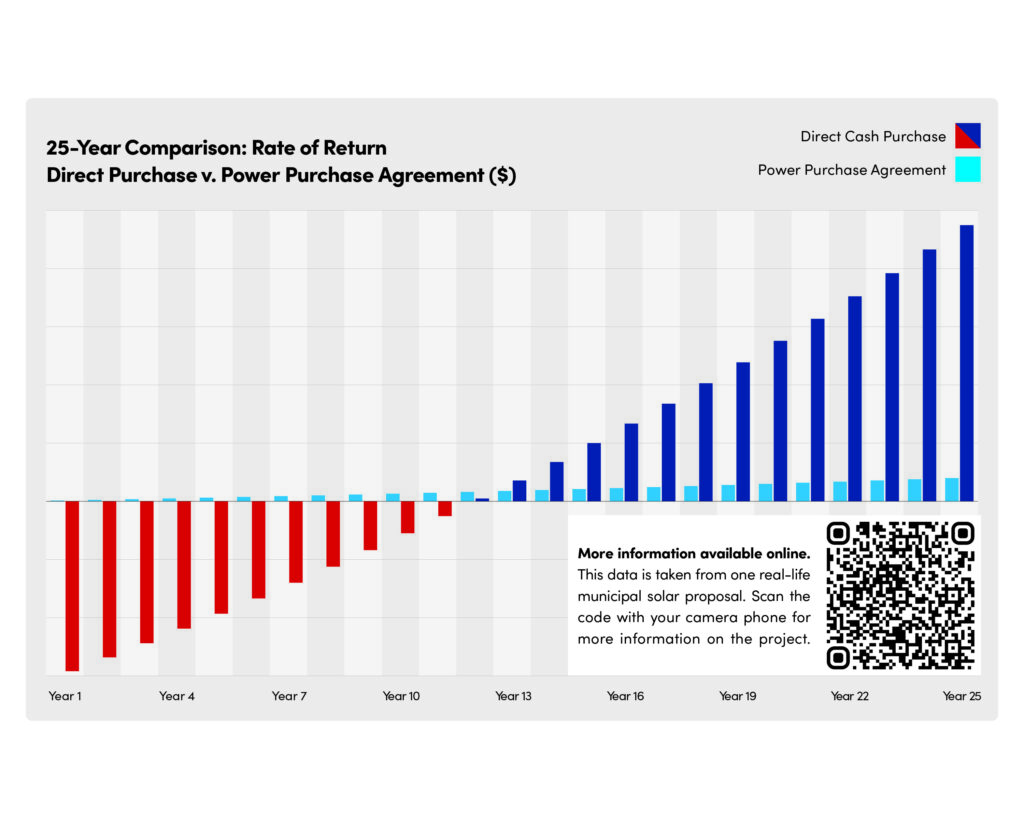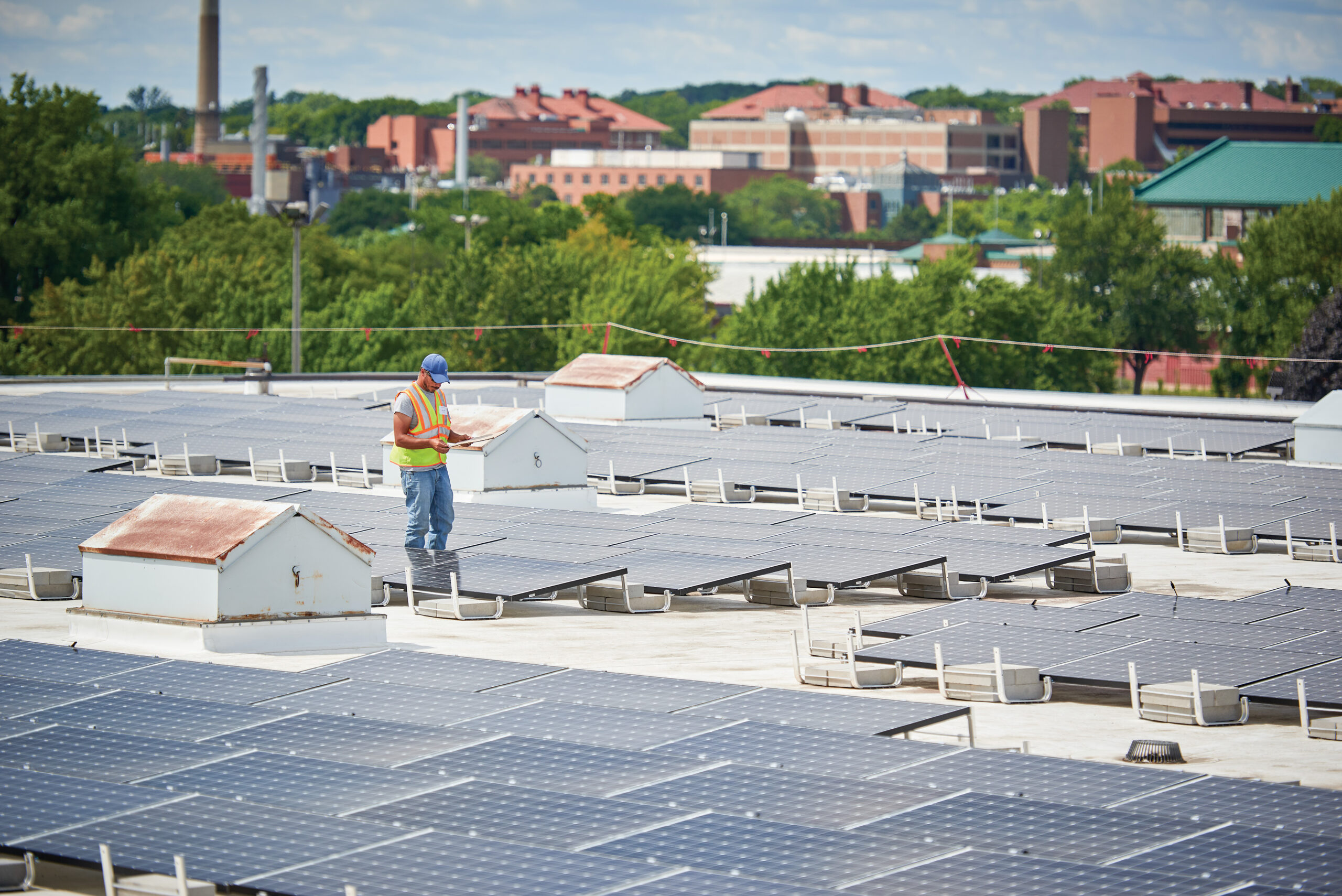Is solar too expensive to be economically viable?
Businesses and municipalities go solar for economic reasons as often as they go solar for ethical or socially responsible reasons. The federal Office of Energy Efficiency and Renewable Energy has reported that the average cost of a solar panel has dropped nearly 70% since 2014. As utility rates continue to rise year over year, solar has been a tool used to hedge against these exorbitant increases. Solar financing options have evolved, making it feasible for non-profit and civic organizations. Between these favorable financing options and the efficiencies gained from increased demand for solar array components, the International Energy Agency (IEA) announced in 2020 that solar power had become the cheapest electricity in history.
Does a solar array require a lot of maintenance?
Most solar arrays do not have moving parts or require regular maintenance. The installation of solar is a relatively straightforward process if you choose an experienced and reliable solar developer. The individual components of a solar array, like panels, inverters, and racking, all carry long-term warranties. The most common service issue is the loss of an internet signal used for remote system monitoring, which doesn’t interfere with an array’s ability to generate power.
Won’t solar fail during Iowa winters?
Most solar arrays work best in cold, sunny conditions. Electrical resistance is lower in cold temperatures, making electricity flow more efficiently, while higher temperatures can reduce the panels’ efficiency. Solar panels get hotter, they produce less power from the same amount of light, a study from the University of California stated. Systems in Iowa can operate more efficiently because of the cooler ambient temperatures. While overall day-to-day power production is lower during winter than in the summer, this is a result of fewer daylight hours and not because of cold temperatures or winter weather. With snow accumulation on solar panels, the combination of three factors; smooth glass surfaces, the warmth of black panels designed to absorb sunlight, and the tilt of panels to face a southern sun, all work together allowing snow to naturally slide off panels quickly.
If I install solar on a rooftop, would it damage the roof or void the warranty?
This has the potential to be true but becomes less likely when working with a reputable solar developer. Many racking systems are designed to mitigate (or prevent) damage to a roof and preserve your roof warranty. On flat roofs, ballasted racking systems allow for rooftop solar without the need for any roof penetration. Depending on the roofing, even pitched roofs allow for non-penetrative solutions. For example, metal roofs can be accommodated with specialized clamps that adhere to ridges or groves without penetrations. This is a case-by-case situation that a solar installer should be eager to review with you. Some solar developers may work with a plethora of potential solutions based on your needs, while others may rely strictly on the penetrative systems that they’re comfortable working with.
Is solar just a “fad”?
Solar energy has been around since 1839, 37 years before the telephone and 43 years before America’s first electrical grid system. Solar has indeed seen significant growth in Iowa over the past decade alone, potentially contributing to this myth. The Iowa Environmental Council reports that municipalities, utilities, and other large facilities have contributed to a 7,935% increase in Iowan solar capacity since 2012 from 2 megawatts to 158.7 megawatts. The success of solar, both in Iowa and nationwide, is indicative of predictable market trends. It’s more affordable and less environmentally toxic than fossil fuels and the market is clearly choosing the better option. A New York Times article published in April of 1956 predicted as much, stating, “it may mark the beginning of a new era, leading eventually to the realization of one of mankind’s most cherished dreams—the harnessing of the almost limitless energy of the sun.” Every day, more people discover solar affordability and environmental benefits, and they choose to take advantage of available solar incentives to help them adopt a clean energy source. Solar arrays are hardly a short-term fad with present-day panels manufacturers offering warranties of 25+ years.
Power Purchase Agreement
America’s transition to renewable energy is already underway. But this transition is no small task and challenges persist. Behind-the-meter solar power is one of the most affordable ways to produce electricity today, but that affordably is seen over decades while the upfront cost of installing solar is immediate. This is a barrier that keeps many cities from going green and adopting lower-cost energy sources. One solution exists to remove this barrier, allowing cities throughout Iowa to roll out carbon-free power without tying up funds in capital investment. That solution is called a Power Purchase Agreement (PPA).
What is a Power Purchase Agreement?
A PPA is a contract between a solar energy provider and a municipality in which the provider agrees to install and maintain a solar energy system on the city’s property. The city then agrees to purchase the energy produced by the system at a fixed rate over a set period of time, usually 15 to 25 years. This means that the city does not pay the upfront costs of installing the solar energy system but instead pays for the energy generated by the system at a rate that is usually lower than what they would pay for traditional grid electricity.
What are the benefits of PPAs?
The most significant advantage of a PPA for cities is that it creates a pathway to reduce your carbon footprint and promote renewable energy without having to make a significant upfront investment. The solar energy provider handles the upfront costs of sizing, procuring and installing the solar project. Without any upfront investment, the city is able to adopt solar and begin saving money as soon as the system becomes operational.
PPAs provide an opportunity for cities to deploy a predictable and price-stable source of energy over a long-term contractual period. “Stable” is the keyword here. The rate paid for the electricity generated by the solar energy system is usually fixed for the duration of the contract, while other electricity sources gradually become more expensive year over year. The stability of a PPA can help cities better manage their energy costs and budget for the future — something especially important for cities that are struggling with budget constraints.

What are the challenges associated with a PPA?
As with any type of long-term contract, a PPA can have drawbacks. While a no-upfront-cost model is very attractive, the rate of return is mild compared to the more substantial rate of return when purchasing solar arrays outright. See the chart for reference.
There are also circumstances where the rate of return (energy savings) can be impacted after a PPA is activated. Steep increases in facility energy usage may provoke a utility provider to modify your rate class, which impacts the projected savings outlined in the PPA. You should understand what happens if your electricity requirements increase over time or if the forecasted energy production is different from the actual production.
If the developer goes out of business or ownership changes hands, it’s important that a PPA clearly outlines a contingency plan for that potentiality.
What are the key planning elements for a successful PPA?
While the specifics of a PPA differ from project to project, there are several key elements cities should discuss with their developer.
- Energy Costs: The electricity rate (preferably a lower rate than existing electricity sources) can be locked-in at the beginning of the PPA or include an annual escalator that increases the rate each year. An escalator may be necessary to account for increases in market energy prices, inflation for system-related costs, project maintenance costs, and array efficiency decreases over time.
- Installation Site Selection: While the developer is responsible for the installation, operation and maintenance of a solar system, the city may need to make investments in their property in order to support the installation of the system, or to comply with local ordinances.
- 3. Quality: With the performance of the PPA tied to the production of the system, investing in a product that has long-term and actionable warranties is a must.
- Fulfillment of the contract: Once the agreement expires, what happens to the array? The usable life of a well-designed and constructed quality solar array can be 30 years and even longer in some instances. Cities should have the opportunity to extend the length of terms for the PPA or negotiate a buyout and outright own the solar array.
What do you consider in selecting a solar provider?
A reputable solar provider will do the following.
- Engage in a consultative process that includes an energy and rate analysis, and will perform a basic site survey. This is done before pursuing any agreement.
- Gain an understanding of the goals and outcomes the city desires to achieve.
- Discuss the benefits of the warranties associated with each product and the installation itself. Beware of vague language that does not name the specific manufacturer of key components like solar panels, racking systems, and inverters.
- Fully explain and document the financial assumptions made in the proposal. Rates, inflation escalators, and production assumptions that are too aggressive create projected returns that may be better than actual results.
An investment in solar is a significant energy efficiency play for a city while also serving as a visual representation of a city’s values. As cities in Iowa have demonstrated, the benefits of solar are realized through successful partnerships with solar energy providers that offer reliable and efficient systems. By exploring the use of PPAs for solar energy systems, cities and municipalities can take a significant step towards a more sustainable future.
Content provided by: Blue Horizon Energy. More information can be found at bluehorizonenergy.com.






